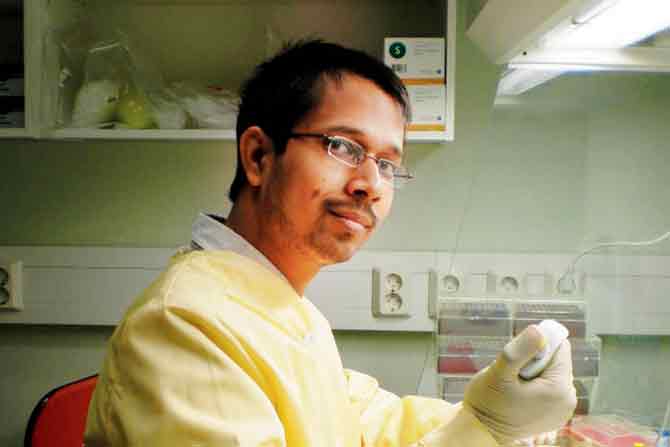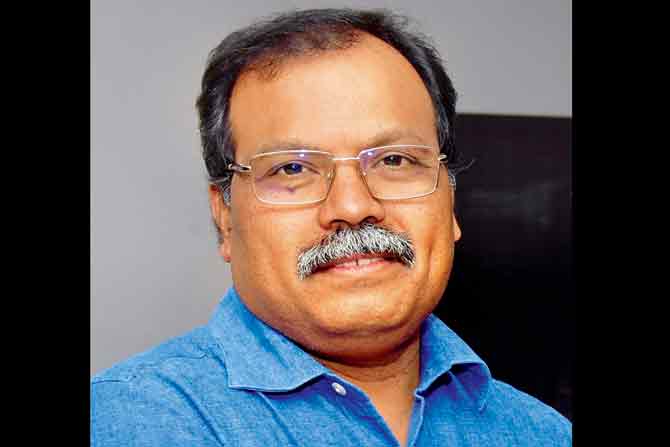Team of international and Indian researchers behind study on how a populations genetic structure affects its response to COVID-19, explain to mid-day why genetic mutation diversity in Indians could be saving us from death, with our reduced mortality

A man plays hop, skip and jump after giving a swab sample for a COVID-19 test in a residential area in Mumbai. Pic/ AFP
A majority of people experience only mild symptoms when they are diagnosed with COVID-19, but a minority will have a severe or life-threatening response. After COVID-19 started its march around the globe, researchers pointed out that those with increased age or underlying health conditions were at a higher risk of contracting the infection. But why some fit, young people are also succumbing to the infection is one of the biggest puzzles of this pandemic," says Professor Gyaneshwer Chaubey, from the department of zoology (molecular anthropology) at the Banaras Hindu University. Understanding how and why the genetic structure of different populations affects their response to COVID-19 and the severity of the infection, could be the answer to all our questions, he feels. "COVID-19 is strangely and tragically selective."
ADVERTISEMENT

A senior citizen who recovered from COVID-19, thanks doctors after discharge from Sood Dharamshala in Chandigarh. PIC/GETTY IMAGES
A study conducted by Chaubey and other genetic experts has explained why the mortality rate of COVID-19 has been higher in European countries and in the US, as compared to India and Southeast Asian countries. "From the onset of the pandemic, our team members have been following the spread of the disease and studying reports across epidemiological and virological literature," says Dr George van Driem, professor of historical linguistics and director of the Linguistics Institute at Switzerland's University of Bern, who has co-authored this study. Driem is a population geneticist and has studied Himalayan populations.

George Van Driem
The results of the team's analysis have been published in PLOS ONE, a peer-reviewed open access scientific journal. The scientists have provided a possible molecular genetic explanation for why Iranians, Europeans and Americans of European ancestry are at a greater mortality risk to the novel Coronavirus than Indians and East Asians, as reflected in the current global distribution of reported COVID-19 cases per 1,00,000 inhabitants. "The main discovery of this study is that Indians should be thankful to their genes for tiding over the pandemic with a relatively lesser mortality rate. We may rank second in terms of number of infected cases, but we have definitely fared better in the global mortality rate," adds Chaubey. On October 10, India's case fatality rate from COVID-19 stood at an impressively low figure of 1.54 per cent. This is far lower than the world average of 3 per cent.
A team comprising distinguished genetic experts from six institutions led by researchers from BHU analysed mutations in the gene responsible for the expression of the Angiotensin Converting Enzyme 2 (ACE2), a protein that sits on the surface of cells and act as an entry point for the Coronavirus into the body. "ACE2 is a protein attached to the cell membranes in certain types of tissues, particularly the lungs, heart, kidney, arteries and intestines. Using the spike-like protein on its surface, the SARS-CoV-2 virus binds to ACE2, almost like a key gets inserted into a lock, before it enters and infects the cells," explains Driem.
ACE2 also helps modulate the activities of a protein called ANG II that increases blood pressure and inflammation. The SARS virus inhibits the pathological effects of ANG II, leading to complications and tissue injury. Which means the more active ACE2 in the body, the better its ability to fight infection.
ACE2 is encoded by a gene located on the X chromosome. What makes this study special is that the team used the more powerful haplotype-based analysis (method in which experts break the whole length of the DNA into several pieces and make comparisons). Chaubey adds, "We found that the haplotype [stretch of DNA containing unique mutations] was present in samples of South Asians. Due to the presence of these gene mutations among South Asians, there is 60 per cent reduced susceptibility against Coronavirus. Whereas among Europeans and Americans, the chances of reduced susceptibility is only 7 to 14 per cent. The difference is huge." This is the positive correlation between the presence of the mutation and the lower infection and case-fatality ratio (CFR) among Indian populations.
 Gyaneshwer Chaubey, genetic expert
Gyaneshwer Chaubey, genetic expert
The team sequenced 483 samples from across the world. These included geographically, linguistically, and socially disparate populations. "Until now, we were thinking that our genome [an organism's complete set of DNA, including all its genes] is closer to Europeans than the Chinese. The ancestry of Indians is linked to African, East European and Iranian countries. But the study revealed that our ACE2 has an affinity to South Asians. Initially, we thought we were getting biased results since the data was less. So, we compared the data of 2,500 individuals from across the world, of which 656 were South Asians. The result, astonishingly, remained the same," Chaubey says.
The world of genetic science is a complex one even when stated in simple terms. However, in recent years, some interesting books have been written by experts that seek to demystify genetic engineering and make the subject more palatable to the common reader. In February this year, the government of India cleared the ambitious Genome India Project. It is described by those involved as the "first scratching of the surface of the vast genetic diversity of India". The Department of Biotechnology will be the nodal government agency overseeing this endeavour, which will use cutting-edge technology in genetic science to map the Indian genome. The core purpose is to use the information gathered to understand the nature and types of diseases that affect the Indian population, and how they can be tackled at the 'root'. Before this, an international programme, the Human Genome Project (HGP), was launched to decode the human genome across the world. Beginning on October 1, 1990, and completed in April 2003, the HGP gave us the ability, for the first time, to read nature's complete genetic blueprint for building a human being.
During the pandemic, one of the most significant genetic studies to date, published in the New England Journal of Medicine, relied on two European populations. In that study, researchers picked through the genomes of 1,610 hospitalised patients in Italy and Spain to find DNA changes that were common among people who developed COVID-19 respiratory failure. The investigators found many patients with severe disease had variants in a complex of genes on chromosome 3.

Kumarswamy Thangaraj
Dr Kumarswamy Thangaraj, whose genetic studies have shown that the enigmatic tribal populations of Andaman and Nicobar islands are the first modern humans who migrated out of Africa through southern coastal route about 65,000 years ago, says his team is also conducting a research on the Indian genome to understand the links with COVID-19. Thangaraj, director of the Centre for DNA Fingerprinting and Diagnostics, says, "We are studying how our genetic variations are associated with COVID-19 infection, progression of the disease, resistance, how people respond to drugs, etc. But it will take some more time before we publish it." Thangaraj says Indians have a better immune system. "For generations, Indians have been exposed to too many pathogens, unlike the more protected populations in European countries. For instance, our ancestors have had multiple mosquito bites. Someone who lived in a remote place, with no medical help and a low immunity, died due to this exposure to the pathogen. Those with a better genome continued to survive after falling sick briefly. Once again, when the survivors were exposed to pathogens, they came out of it. People living in protected environments may get infected severely when exposed to a certain pathogen," he adds.
But, how do genes play out in other epidemics? Have Indians responded to viruses like SARS-CoV-1 or Nipah differently than COVID-19? Driem explains, "This field is being investigated by many researchers, but scientists have only begun to scratch the surface. Just which genes encode for susceptibility to which disease is a big topic. For example, the CCR5 mutation in humans is a genetic trait which confers resistance to HIV infection. It has not yet been possible to conduct studies on humans for all of these diseases, as you can, of course, well understand. In mice, for example, it has been found that the susceptibility allele [each of two or more alternative forms of a gene that arise by mutation and are found at the same place on a chromosome] called Tek determines susceptibility to Ebola haemorrhagic fever. Nobody wants to try this out on people." A final observation is that Indian genes are exceedingly diverse. "The genetic diversity of the many peoples in the Indian subcontinent is far richer and far older than all of the genetic diversity in Europe."
Having said that, Driem warns that an increasing number of people in India have already died of this disease, and we must continue to exercise great caution. "It is important to understand that reduced susceptibility is not the same thing as immunity. Social distancing, good FFP2 face masks and public hygiene remain important."
Keep scrolling to read more news
Catch up on all the latest Mumbai news, crime news, current affairs, and a complete guide from food to things to do and events across Mumbai. Also download the new mid-day Android and iOS apps to get latest updates.
Mid-Day is now on Telegram. Click here to join our channel (@middayinfomedialtd) and stay updated with the latest news
 Subscribe today by clicking the link and stay updated with the latest news!" Click here!
Subscribe today by clicking the link and stay updated with the latest news!" Click here!






